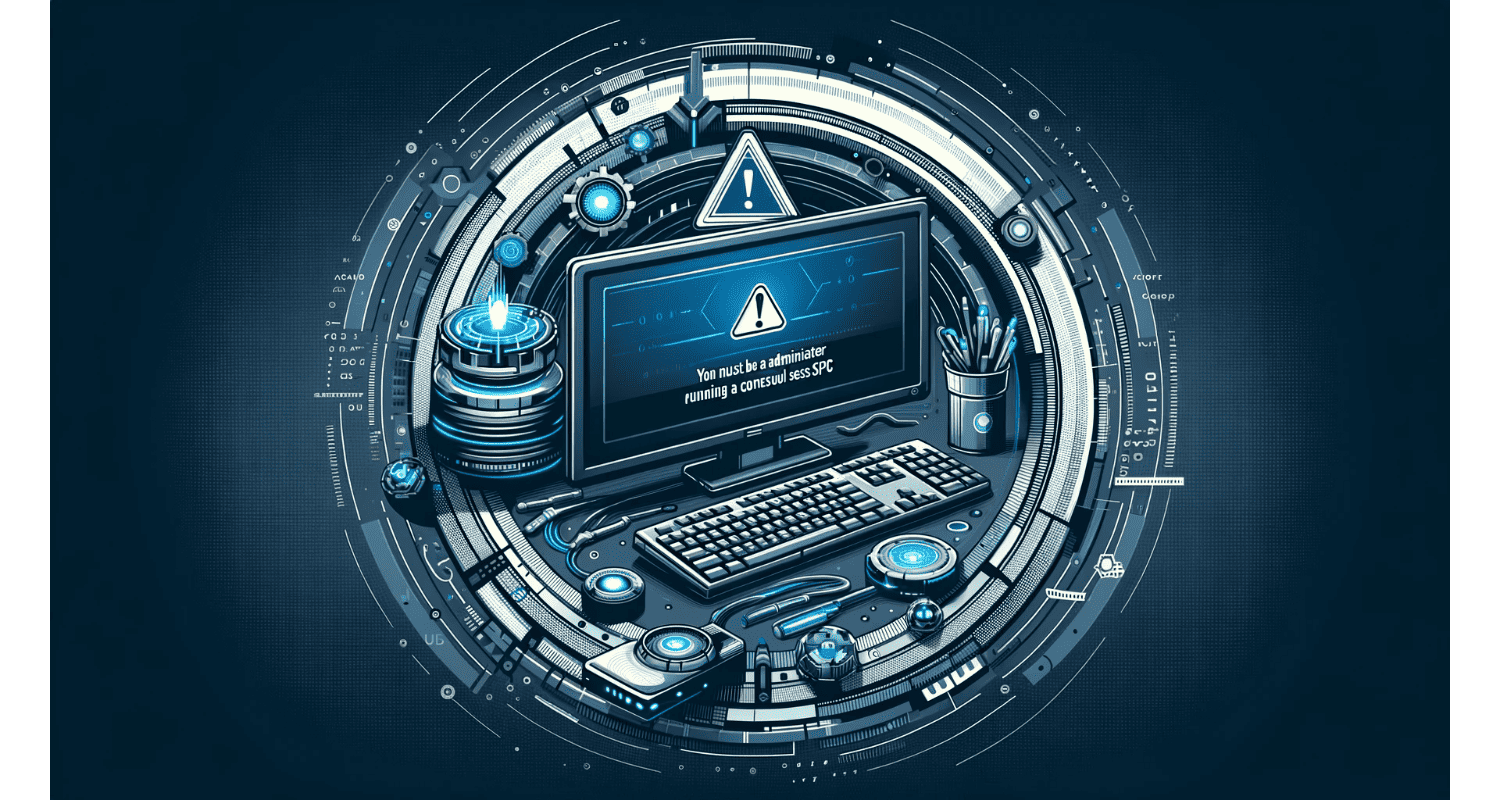Imagine you’re trying to fine-tune your computer, running the System File Checker (SFC) to repair crucial files, only to be stopped by a baffling message like you must be an Administrator running a Console Session SFC. It feels like hitting an invisible wall, doesn’t it? This roadblock isn’t just a minor inconvenience; it’s a barrier preventing you from maintaining the health and efficiency of your computer system.
To resolve the “You must be an administrator running a console session” error when running the System File Checker (SFC), open the Command Prompt as an administrator. Right-click and select ‘Run as administrator.’ Hence, this will provide the necessary privileges to run the SFC command successfully.
But what if there was a clear path over this hurdle like you must be an Administrator running a Console Session SFC? Understanding and navigating this error can transform it from a stop sign into a speed bump. Hence, let’s explore how you can regain control and run the SFC as an administrator, bringing your system back into peak condition.
See Also: How To Fix Steam Game Won’t Launch Issue? [Full Guide]
Table of Contents
Understanding The Administrator Error In SFC Utility
Encountering the administrator error while using the System File Checker (SFC) utility often stems from attempting to access protected system files without sufficient permissions. SFC, a vital tool in Windows, scans and repairs corrupted system files, playing a key role in system maintenance. However, it requires elevated privileges to function correctly, as it delves deep into the system’s core files.
The ‘SFC /scannow’ command is a powerful feature that inspects the integrity of all protected system files. When it finds a corrupted file, it replaces it with the correct version as you must be an Administrator running a Console Session SFC. Hence, this command is a frontline defence in troubleshooting and fixing various system issues, including stability and performance problems. For more details on dealing with system errors, you might want to check out our guide on fixing the ‘Unexpected Kernel Mode Trap’ error.
Step-By-Step Guide To Running Command Prompt As Administrator
Launching the Command Prompt with administrative privileges is essential to use the SFC utility effectively as you must be an Administrator running a Console Session SFC. Hence, this grants the necessary permissions to modify system files. For those encountering difficulties with the Command Prompt or other administrative tools, our article on how to remove ‘Win32:BogEnt’ might provide helpful insights. Hence, here are the steps to open Command Prompt as an administrator:
- Search And Launch: Click on the Start menu, type ‘cmd’, and select ‘Run as administrator.’
- Confirmation: If prompted by User Account Control (UAC), click ‘Yes’ to give administrative permissions.
Here are a couple of alternative methods:
Desktop Shortcut For Elevated Command Prompt for ‘You must be an Administrator running a Console Session SFC’:
- Create Shortcut: Right-click on the desktop, select ‘New,’ then ‘Shortcut.’
- Enter Location: Type cmd.exe in the location field and click ‘Next.’
- Set Name And Finish: Name the shortcut and click ‘Finish.’
- Properties Adjustment: Right-click the new shortcut, select ‘Properties,’ go to the ‘Shortcut’ tab, and click ‘Advanced.’
- Enable Admin Rights: Check ‘Run as administrator’ and click ‘OK.’
Opening Through Task Manager:
- Open Task Manager: Press ‘Ctrl + Shift + Esc.’
- File Menu: Click on ‘File’ and select ‘Run new task.’
- Run Command Prompt: Type ‘cmd’ and check ‘Create this task with administrative privileges.’
Using these methods to run Command Prompt as an administrator will empower you to utilise the SFC utility effectively as you must be an Administrator running a Console Session SFC, maintaining the health and integrity of your Windows system.
See Also: 7 Solutions For ‘Valorant Download Stuck At 0’ Issue
Troubleshooting: Addressing Potential Challenges
Running Command Prompt as an admin can sometimes feel like you’re trying to unlock a secret level in a video game – it’s tricky but doable. When it doesn’t work as expected, the culprit could be anything from user account issues to system glitches. If you’re experiencing difficulty, especially with administrative access, our comprehensive guide on your IT administrator has limited access might offer some valuable solutions. Here’s a step-by-step approach for You must be an Administrator running a Console Session SFC:
- Admin Rights: Ensure you’re logged in with an account with administrative privileges. If you see error messages or the ‘Run as administrator’ option has vanished, it’s time to check your user settings.
- Antivirus Interference: Antivirus software can sometimes be overprotective, blocking legitimate system operations. If Command Prompt isn’t running as it should, turn off your antivirus temporarily and try again. If this fixes the issue, you must tweak your antivirus settings to trust Command Prompt.
- Windows Updates: It’s like keeping your car well-oiled. Regular Windows updates bring in new features and fix bugs affecting Command Prompt. Make sure your system is up-to-date to avoid running into unnecessary issues like you must be an Administrator running a Console Session SFC.
See Also: Fix Forgot Windows 7 Password Hack
Advanced Solutions: When Standard Fixes Don’t Work
Alright, so the standard tricks didn’t do the magic. Let’s dive into some advanced solutions for You must be an Administrator running a Console Session SFC:
- New User Account: Sometimes, your current user account might be the troublemaker. Creating a new user account can often be a clever workaround. It’s like moving to a new house when the old one has too many repair issues.
- Third-Party Programs (like NSudo): When Windows is particularly stubborn, third-party tools like NSudo can come to the rescue. If you’re interested in exploring more about third-party tools and their applications, our detailed article on fixing the ‘Application Unable to Start Correctly (0xc0000005)’ error might be just what you need. NSudo allows you to run programs with full permissions, getting around those pesky restrictions hindering Command Prompt operations. But remember, with great power comes great responsibility – use these tools wisely and understand the risks of granting full permissions to any program.
FAQs
How do I run Command Prompt as an administrator?
Right-click and select Run as administrator. Alternatively, search for 'cmd', right-click on it, and choose Run as administrator.
Why do I need to run Command Prompt as an administrator?
Running as an administrator allows Command Prompt to execute commands that modify system files and settings, providing broader access for troubleshooting and system management.
What are the risks of running Command Prompt as an administrator?
While it gives more control, it also poses risks. Incorrect commands can cause system instability or data loss. Always ensure you understand a command’s function before executing it.
Can I permanently set Command Prompt to always run as an administrator?
Yes, by right-clicking the Command Prompt shortcut, selecting 'Properties', navigating to 'Advanced', and checking 'Run as administrator'. This sets it to always launch with administrative privileges.
What should I do if I can't run Command Prompt as an administrator?
Check your user account for administrative rights. If issues persist, try temporarily disabling antivirus software or creating a new user account with administrative privileges for administrator running a Console Session SFC.
Conclusion
The System File Checker (SFC) utility is a crucial tool as for ‘You must be an Administrator running a Console Session SFC.’ It’s like having a digital doctor on call for your OS, scanning and repairing corrupted files. Hence, running it as an administrator is key to unleashing its full potential. For a smooth experience, always ensure your Windows is up to date, your user account has administrative privileges, and your antivirus isn’t blocking its operation. Hence, regularly using SFC can help nip common system issues in the bud, keeping your computer running efficiently and effectively.
See Also: Fixing A Bad System Config Info Windows 10 | Complete Guide

Dave LeClair is an experienced News Editor at Automaticable. He has written for publications like MakeUseOf, Android Authority, Digital Trends, and more. Dave also appears in videos for MakeUseOf and TheGamer.

